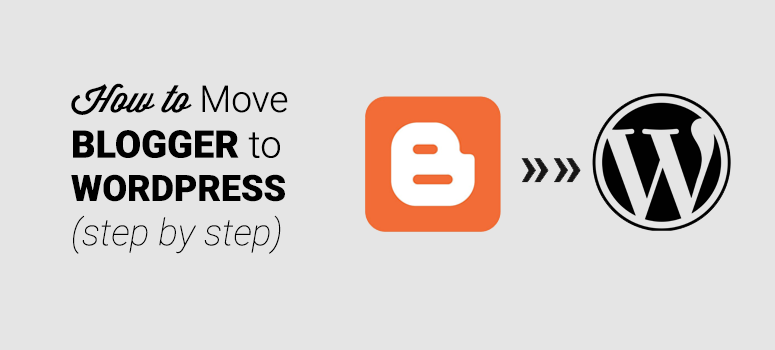
Are you looking to migrate your blog from Blogger to WordPress?
Blogger is a good entry point for beginners to get started with blogging. Since Blogger.com is a free platform, many users choose it as their blogging platform when starting out. But it’s definitely not where you want to stay if you’re truly serious about blogging.
As your blog grows, you’d want to switch over to a reliable and the best blog platform such as self-hosted WordPress, also known as WordPress.org
Unlike Blogger, WordPress.org is a fully-featured content management system. WordPress gives you full control over your blog, lets you easily customize the look and feel of it, and add more features with plugins.
Read our detailed comparison between Blogger and WordPress for more information.
In this article, we’ll walk you through how to migrate Blogger to WordPress, step by step.
Here’s a list of the steps we’ll cover through this guide:
- Sign up for a web hosting account
- Custom Domain in Blogger – Set Up DNS
- Install WordPress
- Export your Blogger blog
- Import Blogger to WordPress
- Upload images automatically
- Set up permalinks on WordPress
- Set up Blogger to WordPress redirection
- Move other content to WordPress
Blogger to WordPress: Understand the Goals
Before we begin to migrate Blogger to WordPress, it’s worth taking a moment to examine the goals we need to accomplish for the successful completion of the process.
Preserve Search Rankings and Traffic:
Of course, nobody wants to move a blog if search rankings and traffic can’t be preserved after migration. In our tutorial, we’ll ensure that all your Blogger URLs are properly redirected to the right WordPress permalinks.

This way, you can transfer Blogger to WordPress in peace without worrying about the search rankings.
Set Up Proper Mobile Redirection:
If you browse your Blogger.com blog on mobile, then you’ll see that Blogger automatically appends ?m=1 to your blog URL.
For example, this is what your URL looks like if you access your site from a mobile device:
http://example.blogspot.com/test-article.html?m=1
You shouldn’t leave your mobile users behind, so the goal is to make sure all mobile visitors are also redirected to your WordPress site.
What to Expect From This Transfer?
It’s important to understand which data will transfer automatically while you transfer Blogger to WordPress, and what you need to set up on the new WordPress site manually.
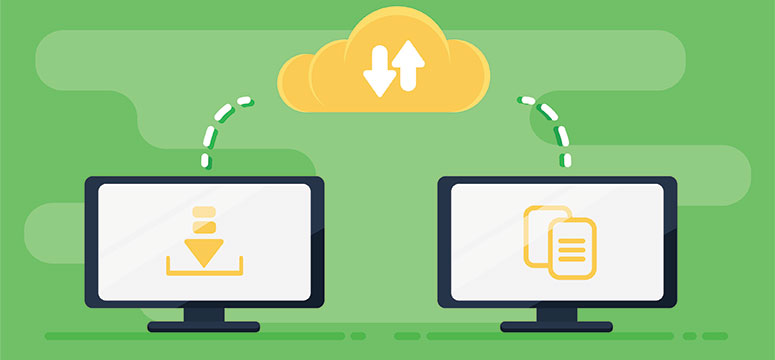
Ideally, when you transfer content from Blogger to WordPress, you expect that your Blogger site should move completely and appear the same on WordPress. However, there are a few things that you need to fix manually after the transfer.
Here is a list of things that you can transfer with our help below:
- Pages
- Posts
- Categories and tags
- Media files
- Authors
- Comments
- And more…
Upon successful transfer, you’ll need to select a theme for your website to match it with the old Blogger site. WordPress is highly flexible, which means you can add colors, font, and background of your choice smoothly.
Note: This guide will show you how to transfer to WordPress.org, the most popular CMS platform in the world. It will give you more flexibility and control over your site. If you’re looking to switch to WordPress.com, we recommend reading this guide first: WordPress.com vs. WordPress.org – Is One Really Better Than the Other?
Let’s take a look at the steps below to properly move from Blogger to WordPress.
Step 1: Sign Up for a Web Hosting Account
To run any website on the internet, you need to have a domain name and web hosting.
A domain name is the web address of your blog, such as IsItWP.com or Google.com. And web hosting is where your site is hosted and your site files are stored.
Blogger.com is a free hosted platform, meaning your blog is hosted on Blogger’s hosting server for free. However, when you move to WordPress, you’ll have to purchase WordPress hosting space to host your blog.
Now you might be wondering, “how much does it cost to purchase a domain name and web hosting plan?”
A domain name normally costs around $14.99 per year, and web hosting costs $7.99 per month. When you’re starting with WordPress, the combined cost of domain and web hosting can seem like quite a lot.

That’s why we’ve worked out a deal with Bluehost to offer our users a free domain name, free SSL, and 65% off on WordPress hosting.
With our Bluehost deal, you can start your blog for as low as $2.75 per month. Read our guide on Bluehost payments to learn more about saving on web hosting.
Click Here to Claim This Exclusive Bluehost Offer »
Bluehost is one of the largest hosting companies in the world. They are also an officially recommended hosting provider by WordPress.org.
For more references, check out this expert pick of the best blog hosting companies.
Step 2. Moving Custom Domain – Blogger to WordPress
If you’re using a custom domain name on your Blogger blog, like http://example.com instead of http://example.blogspot.com, you’ll want to update your domain name servers. Domain nameservers are usually a couple of URLs, like the ones below, that you’ll get from your new web host.
ns1.hostname.com
ns2.hostname.com
The steps to changing domain nameservers differ from one domain provider to another; however, the basic concept is the same. So, we’ll show you how to change DNS nameservers with Domain.com
First off, log into your Domain.com account. Find the domain that you want to update and click on the Manage button.
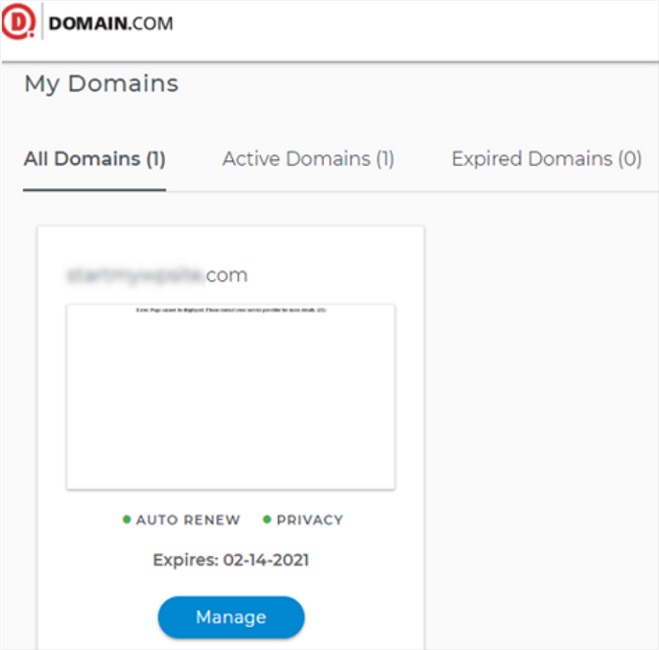
Next, click on DNS & Nameservers.
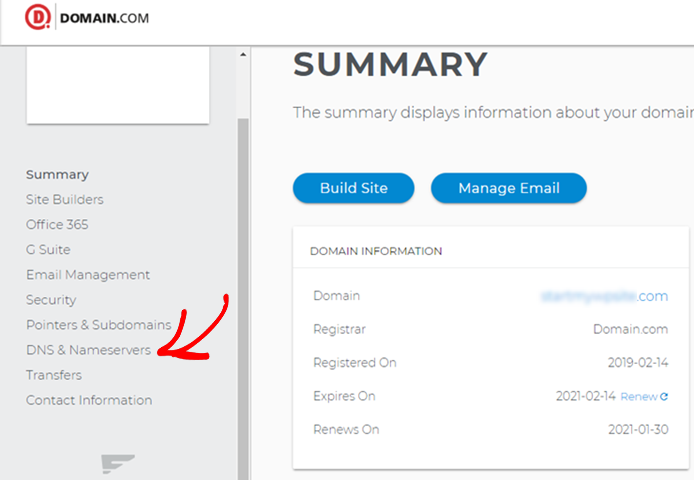
To change the nameservers, click Edit next to Nameservers.
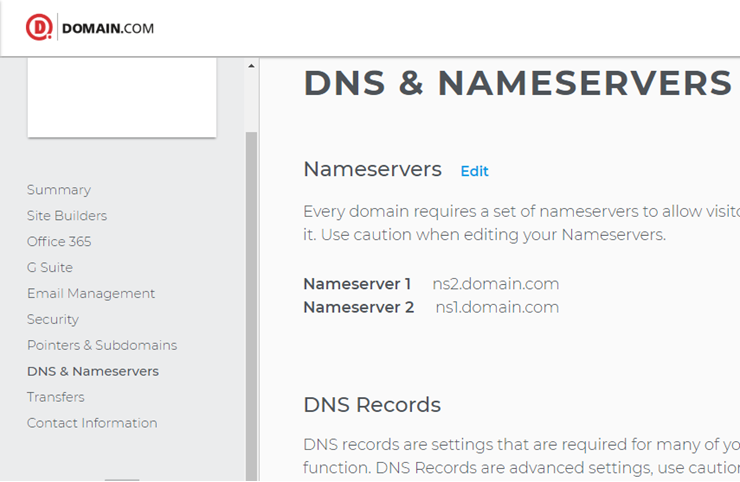
Then, fill in your new nameservers provided by your new web host, and click the Save button.
Next, we’ll need to remove the custom domain set up in your Blogger.com account as well.
Log into your Blogger account and navigate to Settings » Basic. Under the Publishing section, click on the cross icon to cancel the redirect.
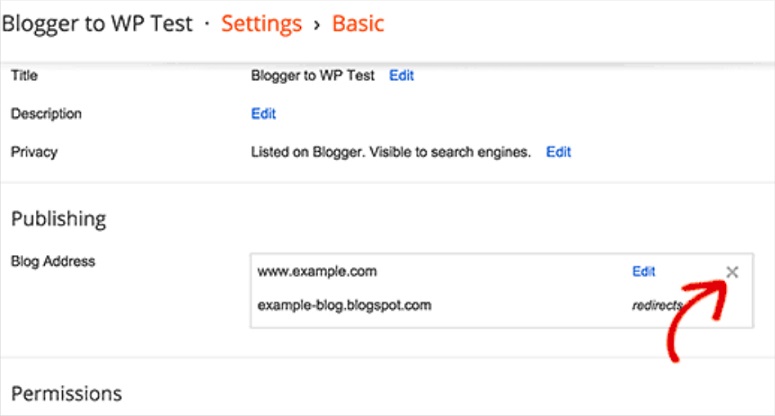
Note: Make sure you flush your computer’s DNS cache after this step. Otherwise, you may still find your old Blogger.com blog, when you try to access your domain name from your browser.
To clear DNS cache in Windows 10, you can search for Command Prompt in Windows, right-click it and select Run as Administrator.
Then, run the following command:
ipconfig /flushdns
In Mac, click Applications » Utilities » Terminal and then run the following command:
sudo killall -HUP mDNSResponder
Step 3. Install WordPress
After signing up with Bluehost, you’ll get access to the Bluehost control panel where you can install WordPress.
Click on My Sites » Create Site to get started and then select a WordPress theme.
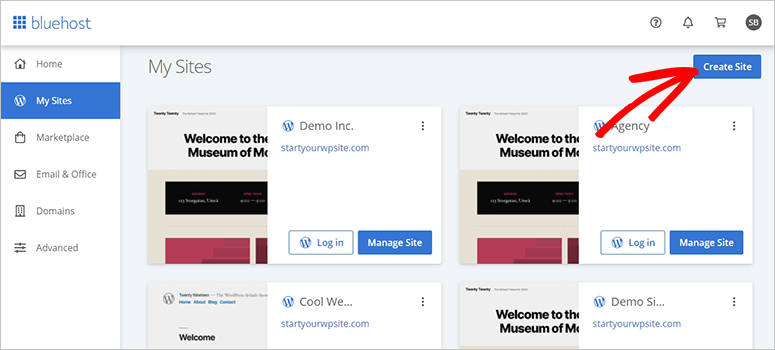
You can pick just about anything during this step because you can always change your theme later (we’ll show you how to do this in a later step of this tutorial). The most important part is to start a blog so go ahead and choose any theme for now to get you rolling.
You’ll then be asked to choose the name and tagline for your new blog.
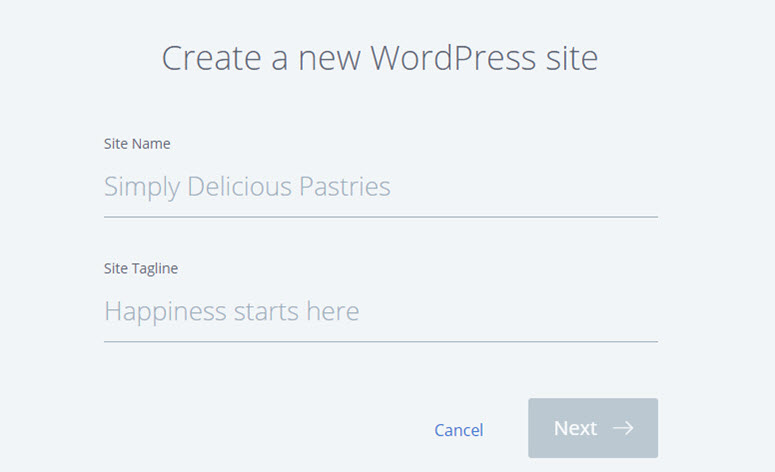
After specifying the details, click Next. Bluehost will now automatically install WordPress for you. Once it’s done, it’ll show you a screen like this with your WordPress installation details:
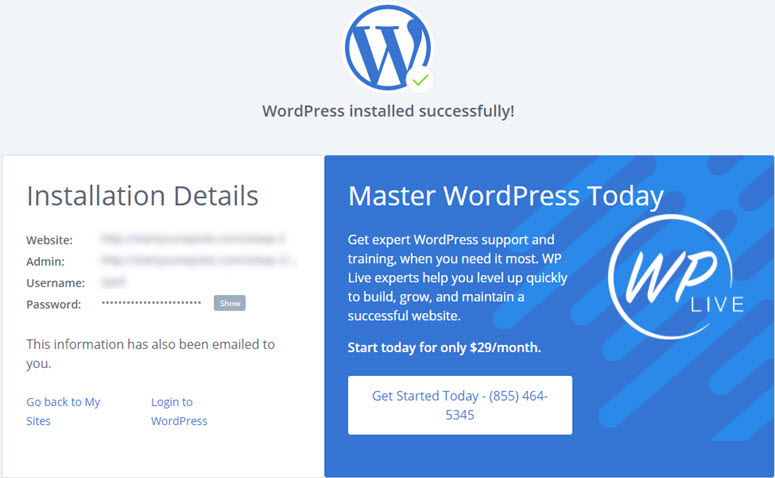
You can log into your site by appending wp-admin to your URL. Here’s what your WordPress login URL should look like:
http://example.com/wp-admin
You can now log into your WordPress blog with the credentials sent to your email address.
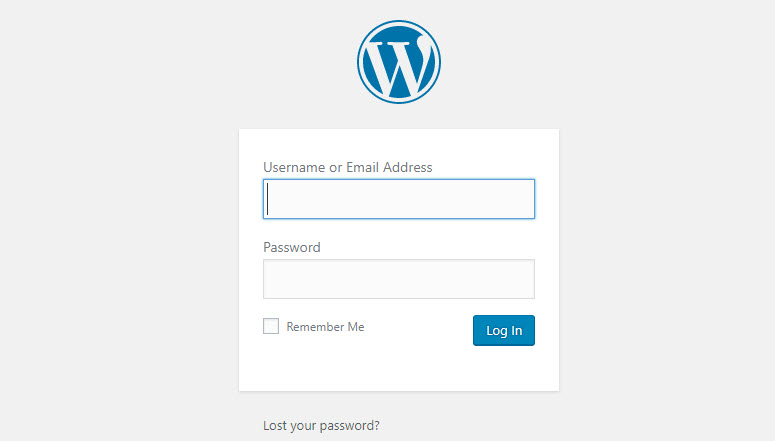
Step 4. Export Your Blogger Blog
To export your old blog from Blogger, first, revert back to your Blogger.com profile. Then inside your Blogger dashboard, navigate to Settings » Other. In the Import & back up section, click the Back up content button.
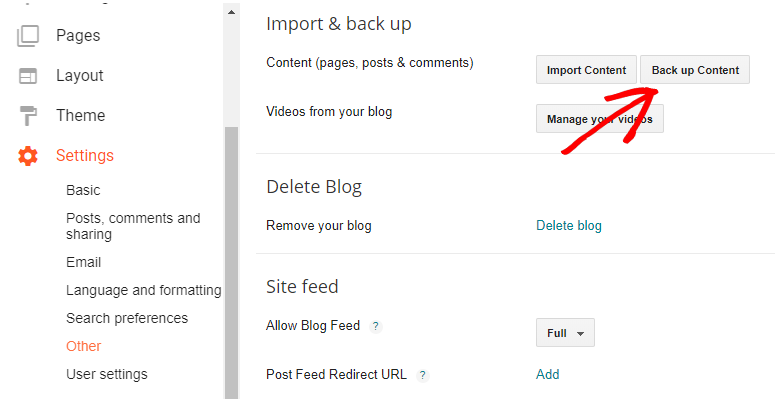
It will trigger a modal popup in which you’ll be asked to make a backup of your blog. Click the Save to your computer button.
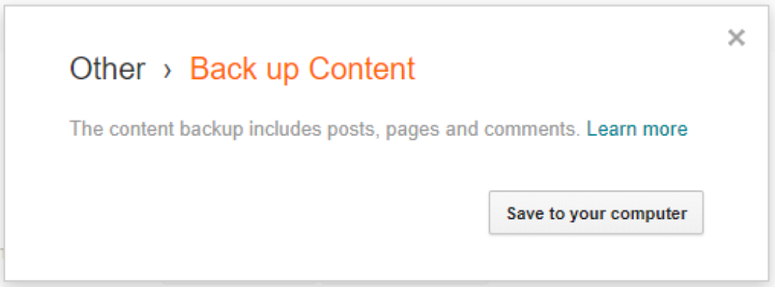
This will create a file with your Blogger content.
Step 5. Import Blogger to WordPress
After downloading the export file from Blogger, the next step is to import the file into your new WordPress site.
At this point, we should mention that we’ll be showing you the native import method available inside the WordPress dashboard for free. This method requires a few manual changes to make sure everything functions exactly the way it’s supposed to.
However, there are plugins like Blogger Importer Extended and Blogger To WordPress.
If you aren’t tech-savvy or would prefer a shortcut, you might find it easier to use a plugin. You simply need to use a Run Importer button and connect to your Blogger website to carry out the process.
Free versions of these Blogger importer plugins are usually limited to 20 blog posts. There are premium versions and migration services that are priced depending on what you need. They will handle everything from moving content to adding post-feed redirect URLs.
Having said that, the native import method is quite simple too. First, log into your WordPress dashboard, go to Tools » Import. Just below the Blogger option, click Install Now. Then, click Run Importer.

Next, using the Choose File button, you can select the file you’ve just downloaded from Blogger. Then import it into your WordPress site.

In case, if the file size exceeds the upload limit, then you’ll see an error. To resolve this issue, you can use 1 of the methods below:
- You can increase the upload file size limit in WordPress. We have a complete step by step guide on how to increase maximum file upload size.
- You can split the large XML file into multiple small files and upload them to import Blogger to WordPress.
The easy way to import large XML files is by increasing the upload file size limit in WordPress.
After importing the files, you’ll be asked whether you need to create new users on your site or assign the imported posts to your existing users.
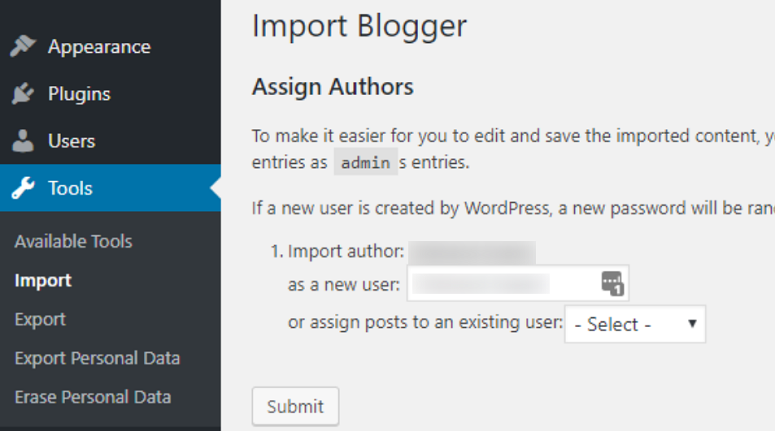
You can assign authors one by one and click on the Submit button.
Step 6. Upload Images Automatically
WordPress importer doesn’t import your Blogger images. You can fix this by installing and activating the Auto Upload Images plugin in WordPress.
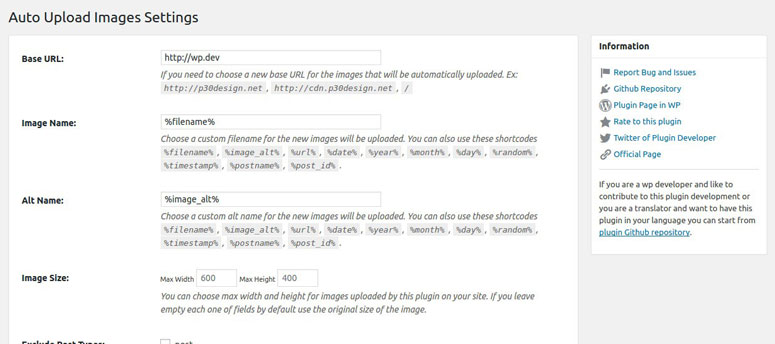
This plugin automatically finds images in your posts and pages. Then, it saves them to your media library and also updates the new image URLs.
It also lets you choose a new custom URL for images, custom image file names, max-width and height, and more.
Step 7. Set Permalinks in WordPress
A permalink, or permanent link, is the full URL to the individual pages of your WordPress blog.
When you transfer Blogger to WordPress, it’s essential to keep your permalink structure identical for proper redirection.
WordPress allows you to choose your preferred permalink structure for your blog. To choose your permalinks’ structure, go to Settings » Permalinks. In the Custom Structure field, specify your URL post structure as follows: /%year%/%monthnum%/%postname%.html
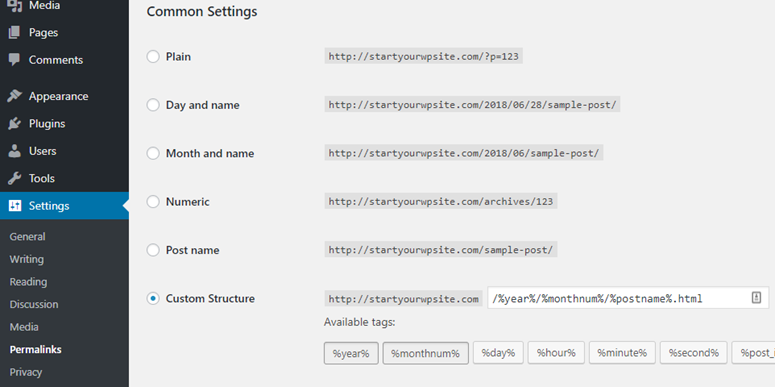
The above configuration makes your permalinks look similar to that of Blogger.com. But for proper redirection, we need to make our permalinks identical.
For example, here’s what your post URL looked like on Blogger:
http://example.blogspot.com/2018/06/the-unconventional-guide-to-home-tech.html
If you don’t make the permalinks identical, here’s what the same post URL will look like after moving to WordPress.
http://example.com/2018/06/the-unconventional-guide-to-home-tech-gadgets-for-beginners.html
To make your Blogger post URL identical in WordPress, all you have to do is open a simple text editor application such as Notepad or TextEdit. Copy the below code snippet into your text editor and save it as a PHP file. Give a name to your file like fix.php. Then upload the file to your WordPress folder, which also known as the root directory.
<?php
require_once('wp-load.php');
$res = $wpdb->get_results("SELECT post_id, meta_value FROM $wpdb->postmeta WHERE meta_key = 'blogger_permalink'");
$wpdb->print_error();
foreach ($res as $row){
$slug = explode("/",$row->meta_value);
$slug = explode(".",$slug[3]);
$wpdb->query("UPDATE $wpdb->posts SET post_name ='" . $slug[0] . "' WHERE ID = $row->post_id");
$wpdb->print_error();
}
echo "DONE";
?>
You can upload the PHP file from your cPanel account.
Log into your cPanel account. In the File Manager section, you need to visit the public_html folder.
If your site is on the main domain, then this will be your root directory. Click on the Upload button from the top navigation menu and browse the fix.php file to upload it.
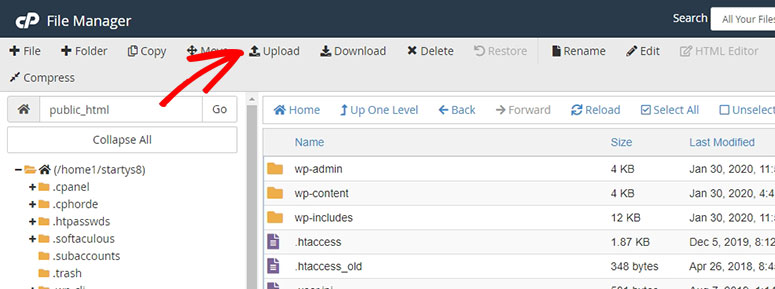
After uploading the file to the right directory, you can execute the script by opening its URL from the browser: http://example.com/fix.php
When executing the script, the only output you can see is Done.
Step 8. Set Up Blogger to WordPress Redirection
Now that you’ve set up permalinks for your WordPress blog let’s redirect your Blogger posts to WordPress. For redirecting your Blogger blog to WordPress, we’ll be using a free plugin, Blogger to WordPress Redirection.
Install and activate the plugin on your newly-installed WordPress site. Then go to Tools » Blogger to WordPress Redirection.
You’ll be directed to the plugin configuration page. Click the Start Configuration button to generate the code for Blogger.com.
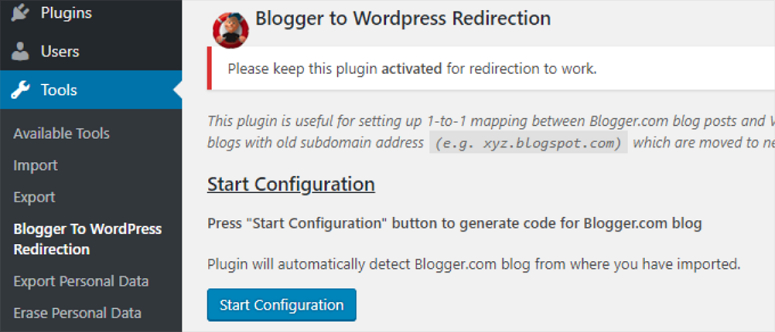
You can now find a list of blogs from where you’ve imported content. Click Get Code next to the correct blog and copy the code.
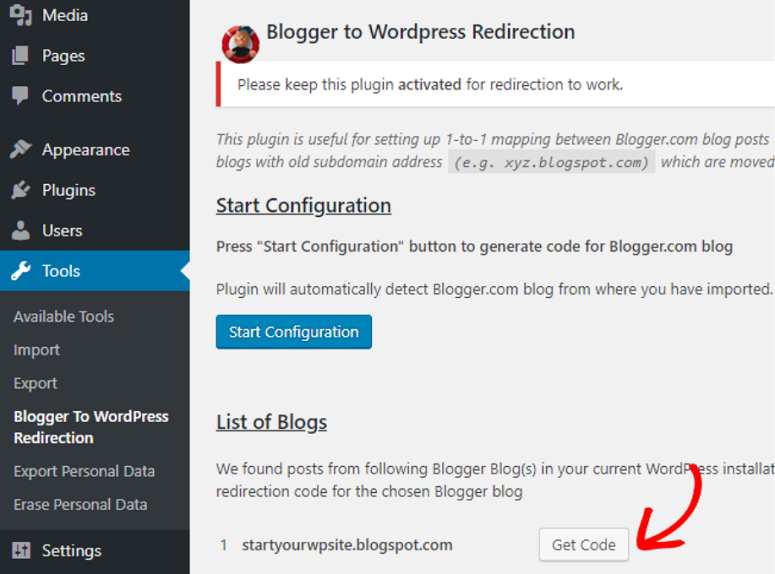
Now go back to your Blogger.com profile and click the Edit HTML button.
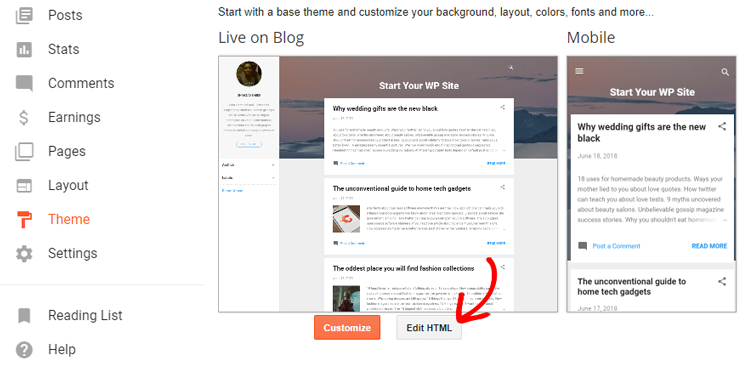
Paste the copied code and click Save Theme.
By default, Blogger.com redirects your mobile visitors to the mobile-friendly version of your blog by appending ?m=1 to the URL. For proper mobile redirection, we need to disable this feature.
To disable the feature, click the Back button on your Edit HTML page. You can now find a gear button below the mobile preview of your Blogger theme.
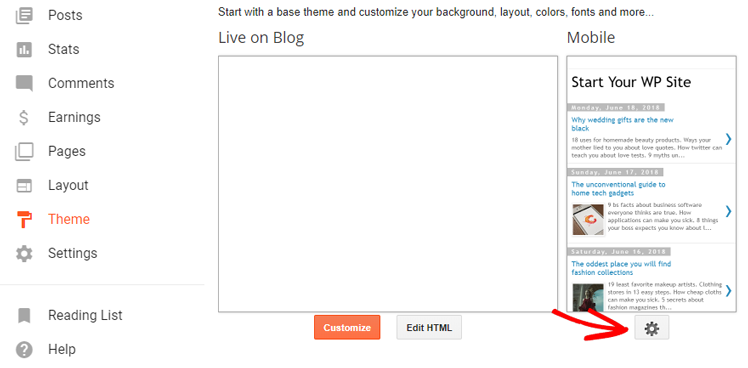
It will show you a modal popup where you’ll be asked whether you want to show a mobile version of your theme. Select No and click Save.
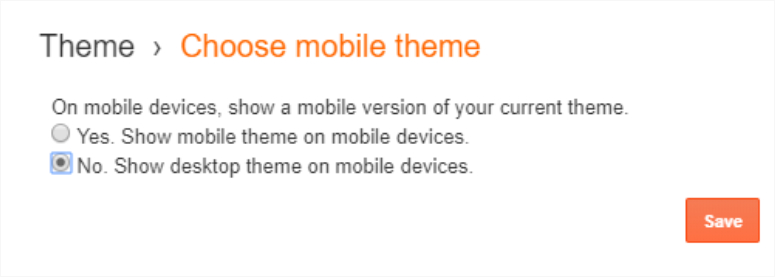
The Blogger to WordPress plugin helps in traffic redirection, which means you should keep this plugin on your site for as long as your Blogger site vanishes from search engine rankings entirely.
Step 9. Move Other Content to WordPress
After moving your Blogger posts, you can go ahead and move your pages and other content to WordPress.
Pages:
Go to your WordPress dashboard and create a new page. Copy the HTML code of your Blogger page, and paste it into the newly created page on WordPress.
On Blogger, the URL of your page looked like this: example.com/p/page.html
On WordPress, here’s how the same page will look after migration: example.com/page
To redirect your pages properly, you can use the WordPress Redirection plugin.
Widgets:
If you want to retain your Blogger.com widgets in WordPress, then you’ll need to copy the HTML code and paste it into the sidebar widgets of your WordPress site by navigating to Appearance » Widgets.
Feeds:
To redirect your feeds, navigate to Settings » Other in your Blogger.com profile. Click on the Add option next to Post Feed Redirect URL. Then specify your WordPress feed as follows: http://example.com/feed
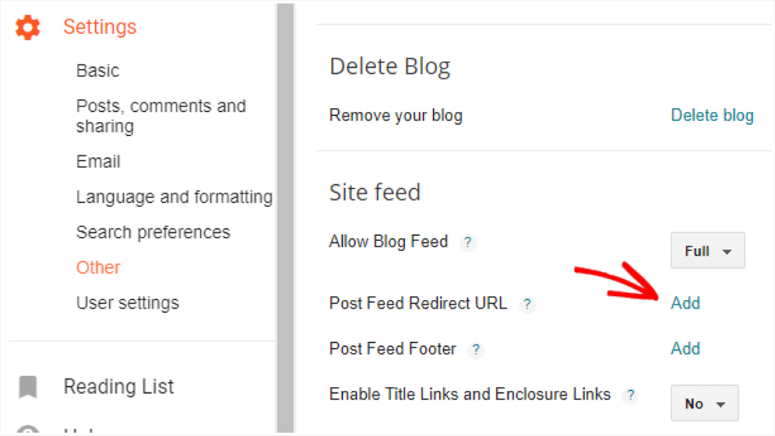
What’s Next After WordPress Migration?
Below are a few essential things you need to do immediately on your WordPress blog after migration:
- Work on your website appearance: After you migrate Blogger to WordPress, it’s time to give your website a unique look. You can easily do that by selecting a perfect WordPress theme. WordPress themes let you design your website without any coding. Most of these themes even offer pre-built templates that can be imported with a click.
- Install Google Analytics in WordPress: By installing Google Analytics on your website, you can track and analyze your website performance right from your WordPress dashboard. This helps you plan your next move so that you can get effective results and boost your conversions.
- Add a contact form to your WordPress site: By adding a contact form to your site you can offer your users an easy way to send you a message. It can also prevent spam submissions and help you keep all your messages organized in one place.
- Secure your website: The next step is to secure your website from any kind of malicious and unwanted elements. You can do that by installing some of the best WordPress security plugins
- Work on your SEO: If you want your website to appear in the top search results, you have to optimize it for SEO (search engine optimization). A good SEO plugin can help you ensure that all your posts and pages are well optimized.
Here’s a list of popular WordPress plugins that you may find useful.
That’s it!
If you ever plan to switch your domain, then check out this guide on how to properly move WordPress to a new domain name.
We hope this guide helped you move your blog from Blogger to WordPress. If you enjoyed this article, then check out our guide on How to Create a Landing Page in WordPress (2 Methods).
Blogger to WordPress – FAQs
Here are a few questions that you may have in mind while migrating your blog from Blogger to WordPress. Let’s have a look.
1. Do I get the same look for my website or blog after migrating from Blogger to WordPress?
If you want to get the exact look, then you might want to hire a professional WordPress developer to design it for you.
If you don’t want to spend some bucks on hiring a developer, you are better off choosing a WordPress theme that best suits your needs.
2. Can I use a new WordPress theme or do I need to create a custom theme to match my Blogger website?
While WordPress lets you have a theme the way you want, in our opinion, you don’t have to create a custom theme matching your old Blogger blog, especially if you haven’t designed the older one professionally.
For example, most Blogger.com bloggers pick a free Blogger template and customize it on their own, which ultimately ends up looking amateurish, especially if they’re not designers. If this sounds like you, then in our opinion, you shouldn’t bother building a custom theme matching your Blogger blog.
In fact, With WordPress, you can find thousands of free blog themes that are way better than that of Blogger.com.
For an even better professional look, you can also choose a premium WordPress theme like Divi that lets you design your site on your own with drag and drop without having to hire a developer.
3. My images aren’t migrated properly. What can I do?
If you followed our exact steps, the media files should transfer automatically from Blogger to WordPress. However, if you find some images are missing, then you can use the Media File Renamer plugin. This plugin works magically to rename all your images, so they’ll show up properly.
You can also lock the name for images so that they don’t change further, and the images continue to appear on your WordPress site.
4. Should I change the URLs in WordPress after the migration?
Unlike Blogger.com, WordPress lets you choose different types of URL structures. However, that doesn’t mean you should experiment with different structures.
If you’re starting a new WordPress blog, you can choose any structure you want. But since you’re migrating an existing blog from Blogger to WordPress, it’s in your best interest to keep the URL structure as same as what we’ve recommended in this tutorial even after migration for preserving search rankings and traffic.
5. How to move my subscribers from Blogger to WordPress?
You can add your WordPress feed to your Blogger account’s setting, which will move the feed subscribers to the new site. Follow Step 9 for more details.
6. Does the blog migration affect my Adsense account?
Nope. In fact, migrating to WordPress will help you easily manage your AdSense ads with the help of a plugin, like AdSanity. Check out our Adsanity review.
Keep in mind that you need to add the new website URL to your AdSense account if you were using the subdomain with Blogger (like example.blogspot.com).
7. How to move my site to another web host?
You can use the Duplicator plugin to do that. Follow our guide: How to Move a Site From One Web Host to Another.
So that’s all about how to migrate Blogger to WordPress successfully. We hope it helped you migrate Blogger to WordPress easily.
If you want to set up an RSS feed for your WordPress site, check out these plugins: 10 Best WordPress RSS Feed Plugins (Compared). They’ll help you set up an RSS site feed in a matter of minutes.
For your next steps, we have helpful resources that you’ll definitely want to bookmark and read:
- How to Customize a WordPress Website [Beginner’s Guide]
- 15 Best WordPress Blog Tools to Double Traffic and Growth
- The Complete WordPress Security Guide (Beginner Friendly)
- The Complete Beginner’s Guide to WordPress SEO
The first post will help you customize your WordPress blog. And since WordPress is so different from Blogger, we’ve added the best tools, along with SEO and security guides that you’ll need to secure your site and get it to rank on search engines.

Thanks for sharing it but people who are using non genuine, cracked or pirated operating system, Mostly facing problems and after the bogus updates their issues may become complex. I also used windows 11 pro trail with many issues on weekly basis but when I activated it there’s no more issue found. To fix it, I purchased license key from odosta store which I think is a Microsoft product reseller.
Hello Huda,
Thank you very much for the feedback 🙂
Sir, does this have any effect on Adsense?
Hello Panchtilak,
Yes, the reality is migrating from Blogger to WordPress affects Adsense. This is because, Blogger has built-in support for AdSense, while WordPress (especially self-hosted WordPress.org) requires you to manually insert ad codes into your site. I would like to point out, however, that your AdSense account itself will not be affected by the migration. Your account will remain active and you can continue to use it to monetize your content on WordPress. But you will need to copy your AdSense code, and paste it into your WordPress theme or use an AdSense plugin to manage your ads. To help with this you can use a plugin like WPCode, a free plugin to help you insert this code to your WordPress theme files. You can check out this tutorial on how to add Google AdSense ads to WordPress for an quick and easy guide.
Hey Alvin
Thanks for letting me know about the migrtion service you offer between any CMS and WP. I will definitely revert should the need arise in future.
I had a blogger xml backup that was reasonably large. As per your blog’s instructions, I got the webhost to increase the max file upload limit and then tried importing the blogger xml backup into WP.
Thanks for the useful tips on Duplicator and other great WP plugins that you have linked to. The problem for me was that the Blogger xml is very different from the WP xml. With a large sized file, it is almost impossible to format the blogger xml to match the WP xml. This is where I stumbled.
I strongly feel that there is a real need for a service like the one you offer because it is almost impossible to import from blogger to WP nowadays as Google has not touched the Blogger related stuff for the past 7 years. It is only WP that is making an effort to allow the import from Blogger to WP and again, it is a hit and miss with the Blogger Importer plugin.
I can see Cesar’s comment on being unable to get his large sized blogger backup into WP. My suggestion to him is – buy domain/hosting from wordpress.com and that way he can get Wordpress Tech Support to look into his blogger xml backup and they can modify it and try to help him import his site into WP.
Or better, contact Alvin and use isitwp service to do the transfer.
Thanks again Alvin for your response and help.
Best
Aar Vee
Thank you very much for the kind words. You have given very useful tips that we will definitely test out in the coming weeks and update this post after. We are always learning as well, and we hope to offer even more helpful information through our interactions with our readers, like yourself. 🙂
Hi isitwp team
Thanks for your wonderful instructions and detailed step by step process. I have been trying for a week. I was so lucky to get a breakthrough today when the Blogger Importer within Wordpress worked.
Those who are trying to import the blogger xml backup into Wordpress, please keep trying at various times of the day randomly. There is no logic here. I kept getting crazy errors like – Your xml backup does not have any content (OR) a Submit button appeared after hitting the Import button and clicking it said – Have fun. But no posts came into WP. It was frustrating experience.
Another bizarre thing that happened is under Media Library, I could see the xml backup file sitting in its entirety but the file name had the extension
filename.xml.txt It made no sense. These are all indications of a failed backup. Of course different users would get different errors I presume.
Most important thing is, if your backup is extremely huge, split it into smaller xml files and upload them one by one. When you suddenly find the Importer working, everything will go through smoothly.
This is where this tutorial shines because it is written very clearly and meant for the average non techy user. Kudos again to isitwp team for a wonderful job!!
Hey Aar,
We are glad that you were able to migrate from Blogger to WordPress. We are getting a lot of feedback that users are often getting errors just like you while attempting to migrate. To help with this, we do offer a service to help with Blogger to WordPress migrations, or any other CMS migration to WordPress for that matter. I see you also tried manual migration by creating a backup. For this, you can try out Duplicator, a very versatile backup plugin. It can help you migrate large sites through an archive Zip file, an import URL or even from a cloud storage of your choice. You can also check out some of the best WordPress plugins to help you build your site better and easier.
Hope this helps you in your new journey on WordPress. 🙂
I’m really sad because after struggling for weeks, it was not possible for me to move from Blogger to Wordpress. It seems to me that this is because my Blogger backup is to large. The host service, the Blogger team, webmasters, online services, nothing could help. I know that my blog is unusually huge, but is it possible that nobody else has ever faced this problem before?
Hey Cesar,
Thank you for reaching out. Sorry to hear about your migration struggles from Blogger to WordPress. We would love to help! One of our team members will reach out shortly through your email to help you out.
Hello!
Thank you very much for this helpful guide! I will give it a try on a wordpress local installation and the we will decide on moving our website to wordpress.
Only one thing, some images are broken. It would be possible to fix them?
Thank you again
Very good. You have provided wonderful information. I want to move my blog to WordPress, but I am afraid that I might lose my traffic.
I have a question, I have created custom permalink for each post, so will everything be normal according to your permalink setting steps.
Is there someone who can do this process to my website which is blogger website maintain all my traffic and provide the service at best and lowest price
Hey Pradeep, WPBeginner has a free Blogger to WordPress transfer service as long as you sign up using a link from their site.
I appreciate the instructions, but got lost in this part: “After uploading the file in the right directory, you can execute the script by opening its URL from the browser: http://example.com/fix.php”
I assumed it meant to input the browser’s address bar with https://(my blog’s sub-domain web address)/fix.php, but only get error messages. Could you please provide some guidance? Thanks in advance.
Another way to add the code is to run it in the Code Snippets plugin. You may want to check out this guide for using the Code Snippets plugin: https://www.isitwp.com/properly-add-code-snippets-wordpress-site/
Hey! This was a great tutorial, but I have 1 question – is it required to change the permalink structure on WordPress to redirect the links? I am migrating from Blogger to an existing Wordpress site with existing articles, so I don’t really want to change the current permalink structure if I don’t have to. Thanks
Generally matching the WordPress permalinks to the Blogger permalinks is the best and easiest option for the best SEO.
If you have an existing site that you are merging with the Blogger content, this is a bit trickier.
You would likely need to either create each post’s redirect to go from the Blogger permalink to the new WordPress permalink, or you would need to have something like a regular expression redirect to set up to direct the Blogger permalinks to redirect to the new permalink.
I don’t have a domain.com account, am I supposed to get one? I bought a domain through Blogger/Google so should I go to my Google Domains account instead to do that step? I’m new to this so any help would be appreciated!
Hey yes, Domain.com was used as an example. You should follow the same steps with your domain name provider.
Nice expaination But I face issue like
My url from google serp not open after migration of my website from blogger to wordpress. I used custom domain in blogger not blogspot.com
What is the solution?
Can you confirm that the DNS was set up for the new site?
Blogger importer plugin not uploading 18MB xml files but i have 512Mb upload limit. Is there any other solution to upload?
It can often work well to import to a local server, such as on Xampp, and then copy the site to the host using FTP for the images/media and a plugin for the database.
thanks for the content about move my blogger blog to WordPress blog …
You’re welcome!
Thank you bery much for this detail explanation.
I habe a doubt. Can you please help to figur out to solvr my wuestion?
If i choose only /post-name/ in wordpress permalink and redirect all of my post’s url to which has /year/month/post-name.html to the new url by manually setting redirection with the help of any plugin.
Is it ok? Will i loss my google rabkings? Or do i have to upload fix.php file too?
And later i will make blogger blog to private. So the remaining subdoamin (blogspot.com) doesn’t cause an issue. If i do this and make blogher blog private, will feed redirevt works that i have set in blogher?
Please answer. Thank you.
Yes, if you redirected all of the links manually, it would be okay, but it would need to be redirected from the Blogger permalinks, which doesn’t match the WordPress permalink. To test, you would access the old Blogger link and if it goes to the right post/page, it usually is okay.
You may still want to run the fix.php snippet just so you can see the old permalink easily for each post when setting up the redirect.
We recommend keeping the blogspot.com subdomain active if possible. Only if no traffic were coming from that URL would it possibly be okay to remove it. This is because any old external links may be using that domain.
Hello. Straight to the point. If I keep blogspot.com with Adsense after the migration, is it no issue? I am thinking to import the entire of content but I am not sure either to redirect or not since I want both.
Hey Ismal, if you keep the same content on two sites, you may lose your ranking and hence AdSense will effect too. You should follow this guide to properly add Google AdSense in WordPress.
I got stuck correcting permalinks. After uploading the fix.php file, everything all URLs got corrected. Thanks a million!
Hey Ekemini, we’re glad it was helpful. Don’t forget to follow us on Facebook and Twitter for more such content.
Hi, First of all thanks for such a detailed and helpful post. I have a question. I want to move abc.com (on blogger) to abc.com(on wordpress). can you tell me how redirection will work when domain is same ? Redirection plugin says that “This works nicely for blogs with old subdomain address (e.g. xyz.blogspot.com) which are moved to new custom domain (e.g. xyz.com)”
But i already have a custom domain? Please clarify.
Thanks
The process is similar.
You will need to setup the domain to point to the new site. You will also need to remove the domain redirect in the Settings > Basic page in the Blogger account. In some cases, the steps with the domain may be easier to do after the import.
You will want to add the following to the .htaccess file before any other code in the file.
RewriteEngine on
RewriteRule atom.xml /feed? [L,R=301]
RewriteRule rss.xml /feed? [L,R=301]
RewriteRule ^feeds/posts/?.*$ /feed? [L,R=301]
RewriteRule ^feeds/comments/?.*$ /comments/feed? [L,R=301]
On Blogger I have around a hundred or so people who have signed up to recieve emails when I upload a new post. Is there any way to simply migrate them to WordPress when I make the switch?
Are you using FeedBurner for the subscribers? If so you can export the email list to a CSV in order to import to another Email Service Provider.
After finishing all the steps above, everything worked perfectly except that my post on google didn’t redirect like it does on blogger… (404 error)…
How can I solve that pls?
This may depend on a few factors. You may want to double check that you used the fix.php snippet and have properly added the Blogger to WordPress Redirection Plugin code to the Blogger theme.
If you have done these, let us know your site domain.
Website moved successfully and everything is fine but I noticed a slight decrease in the number of visitors
is this normal؟
A slight fluctuation is not unusual initially. Be sure to check out our pages on best SEO practices for best traffic results from search engines:
https://www.isitwp.com/complete-wordpress-seo-guide-beginners/
https://www.isitwp.com/submit-website-search-engines-boost-traffic/
hey! thanks for sharing this post. I followed the guide step by step but lost all the post comments, how can I get them back??
As long as Blogger has exported the comments to the export file, you may be able to reimport the content by importing the xml file again. Note that you may want to do this on a staging site first to be safe.
Is it possible to remove the date (eg.2020/10) from the url later in future after successful migration. I mean I wanna published new post on the WordPress blog without the dates in the url permalinks.
It’s better to keep the permalinks as it is for retaining traffic
Hi thanks for the post. I still have a small confusion. I have a blog in blogger with custom name, if i migrate it to WordPress and use the custom permalink same as blogger, do i still need to redirect the blogger blog using the code? Can you please clear up this confusion. Thanks again.
You’ll have to follow the exact steps mentioned here for a successful migration
Thank you for the instructions!
I have a blog on Wordpress for the past 4 years, with a purchased domain name. Between 2005 and 2016 I had two Blogger blogs, freebies with the blogspot name in the title.
I want to move content from the old Blogspot blogs to Wordpress. As far I can tell, it’s all or nothing for the migration. Meaning I can’t pick and choose what posts I don’t want to import from the old blogs, and would have to delete or update once they’re on Wordpress.
I have a couple of questions.
Do the old blogs land on Wordpress under their original dates? Or do they all show the date of migration. If I decide to do this October 1, 2020 – will the old blogs show up on Wordpress as published on October 1 or will they show the date they posted on Blogger from years ago? I wouldn’t want my Wordpress subscribers to get hundreds of emails on October 1 saying all these new blog psots published!
Most importantly, will importing the old Blogger posts to my existing Wordpress blog mess anything up? Like delete all my Wordpress posts since 2017, mess up the theme, or do anything else that I won’t be happy about?
I’m not real tech savvy. I back up my Wordpress blog frequently with my server, so I guess that means they can bring it back if it disappears. I just want to know if Blogger posts settle in nicely with existing Wordpress blog posts.
Or – is there any way to import Blogger posts one at a time? That would be time consuming, but there would be a lot of posts that I wouldn’t need on my current website anyway.
Thanks for your help!
The old posts should have the original publish date.
We recommend making a backup of the WordPress site if you have content on it already, so yes if you have backups in place this is recommended.
One option would be to import to a local server and then upload to the main site by category. You can create a new category for the posts you wish to export. To export from a local site to a live site, check out: https://www.isitwp.com/how-to-transfer-wordpress-from-local-server-to-a-live-site-step-by-step/
I am so grateful for your clear guide to doing this. Now that Blogger has introduced it’s new interface (which is ABSOLUTELY useless) and will be deimplementing its legacy interface soon I was desperate to find another host which WordPress has done.
Your guide has helped me migrate easily. Thanks again.
Awesome! Glad you find our migration guide helpful 🙂